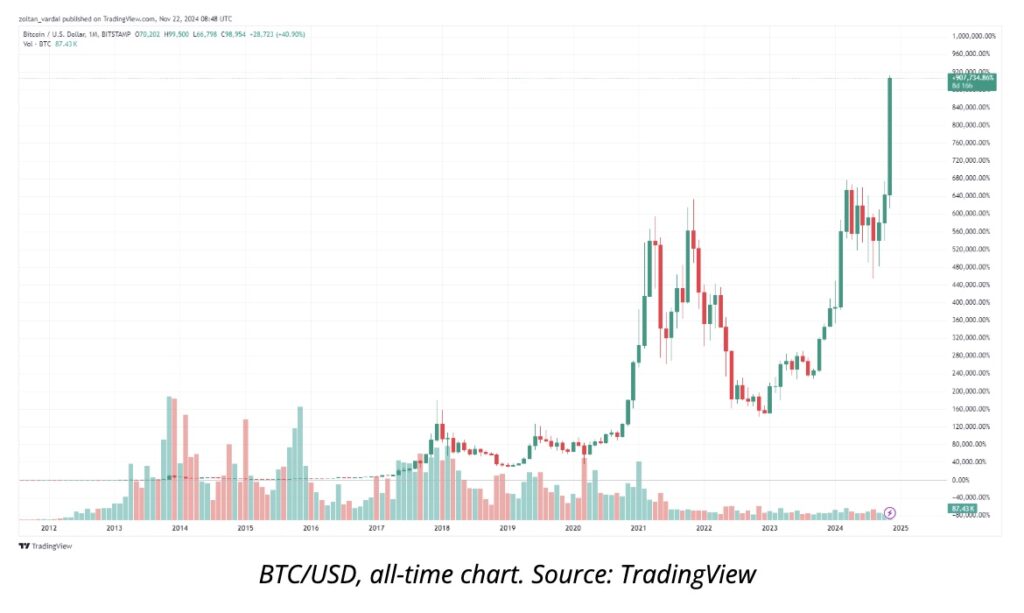Bitcoin’s $99k surge marks a historic event in digital finance, highlighting the cryptocurrency’s shift from a speculative asset to a recognized store of value.
This spike is more than simply statistics; it represents a fundamental shift in the perception and utility of cryptocurrencies. Let’s explore the milestone of Bitcoin’s $99k surge.
Table of Contents
Bitcoin’s $99k Surge: The Milestone

Bitcoin’s rise to a price of $99K is an important milestone in its history, driven by a mix of market dynamics, macroeconomic variables, and network fundamentals.
A snapshot of the price journey
Bitcoin’s steady growth has been punctuated by significant surges related to historical and economic milestones. Early price hikes in 2017 and 2021 helped establish Bitcoin as a legitimate investment asset, with institutional adoption playing a critical role.
The path to Bitcoin’s $99K surge highlights not only speculative interest but also its maturity as a digital asset tied to macroeconomic and technological shifts.
Key Factors Behind the Bitcoin’s $99k Surge:
Key Catalysts Behind the Surge: Bitcoin’s acceptance by big institutions like Tesla, MicroStrategy, and Grayscale increased its legitimacy, transforming it from a speculative asset to a reliable store of value. Institutional demand soared, resulting in consistent price growth.
Bitcoin halving: Scheduled halving, which decreases mining incentives, has a consistent impact on supply. Bitcoin has historically rallied before and after halvings, with a post-halving supply shock adding to price momentum.
Macroeconomic influences: Loose monetary policy, quantitative easing, and inflation fears have pushed investors to consider Bitcoin as a hedge against fiat devaluation. Additionally, the anticipated approval of spot Bitcoin ETFs fueled investor optimism.
Regulatory Advances: The approval of spot Bitcoin ETFs, as well as clearer regulatory frameworks in numerous jurisdictions, have minimized entry barriers and facilitated greater use. The regulatory clarity has increased market confidence, attracting more traditional investors to the crypto space.
Market Dynamics & Sentiment: Bullish market sentiment, driven by broad acceptance and growing media attention, has contributed to Bitcoin’s soaring prices. Whale activity, including big Bitcoin acquisitions by heavy business entities like MicroStrategy, highlights the growing long-term trust in crypto.
Broader Ecosystem Growth: Bitcoin’s dominant position in the crypto market has an impact on the broader ecosystem, attracting new capital and participants. As Bitcoin rises, altcoins frequently follow suit, resulting in a market-wide rally. This strengthens Bitcoin’s position as the top digital asset.
Comparison of Bitcoin’s $99K Surge to Previous Highs
Bitcoin’s $99K surge is a double of its 2021 peak of $69,000. This growth indicates not only increasing usage but also enhanced market resilience, as shown by decreased volatility and an increased share of long-term holders in the market.
Bitcoin’s integration with DeFi and scaling solutions, such as the Lightning Network, has increased its utility and contributed to its value.
The Bitcoin’s $99K surge heralds a new era for Bitcoin, in which its role expands beyond speculative investment to become a cornerstone of the global financial landscape.
This milestone is more than simply a reflection of a price increase; it also demonstrates the maturity and legitimacy of crypto in the financial world.
Why Bitcoin’s $99K Surge Is a Game-Changer for Digital Assets:
Bitcoin’s unprecedented price surge to $99K marks a historical phase in the growth of digital assets, highlighting the interplay between technology innovation, market dynamics, and global financial trends. Here’s why this milestone is transformational:
Market Legitimization: From Speculation to Stability
Bitcoin’s $99K surge marks Bitcoin’s shift from a speculative asset to a legitimate financial instrument. Institutional investors, who were originally skeptical of Bitcoin, have now embraced its potential as a hedge against inflation and economic upheaval.
High-profile endorsements, adoption by Fortune 500 corporations, and the approval of Bitcoin ETFs have all boosted its credibility in conventional financial ecosystems.
- Key impact:
- Institutional confidence: The price surge validates Bitcoin’s status as a dependable investment vehicle, prompting asset managers and pension funds to adopt it in their portfolios.
- Global recognition: Central banks and governments are adopting a more balanced approach to regulation, acknowledging Bitcoin’s importance in modern finance.
Ripple Effects Across the Digital Asset Ecosystem
Bitcoin’s surge has a cascading effect, increasing the value and prominence of other cryptocurrencies.
Altcoins, particularly those with compelling use cases like Ethereum and Solana, benefit from renewed investor interest, while emergent areas like decentralized finance (DeFi) and NFTs are seeing growing adoption.
- Key Impact:
- Altcoin Growth: Investors diversify into lesser cryptocurrencies, driving blockchain innovation.
- Broader Adoption: Retail and institutional participation in crypto markets is increasing, fostering a strong and interconnected financial ecosystem.
Economic and technological implications.
Bitcoin’s price milestone highlights its ability to disrupt traditional finance by providing a viable alternative to fiat currencies and outdated institutions. It also promotes technological advances in blockchain scalability, energy efficiency, and financial inclusivity.
- Key Impact:
- Decentralized Finance (DeFi): Bitcoin’s success enhances DeFi protocols, offering users an alternative to traditional banking services.
- Financial Inclusion: Bitcoin’s global adoption minimizes the challenges for underbanked people to participate in the digital economy.
A catalyst for regulatory clarity
Bitcoin’s $99K surge has prompted governments to develop clearer regulatory frameworks. Regulatory certainty stimulates institutional adoption, which reduces investment risks and stabilizes markets.
- Key Impact:
- Policy Development: Governments and regulators worldwide create rules to integrate Bitcoin into their economies and address concerns about fraud and volatility.
- Infrastructure Evolution: Improved regulations result in advancements in custody solutions, payment gateways, and blockchain interoperability.
Positioning Bitcoin as “Digital Gold”
The Bitcoin’s $99k surge strengthens Bitcoin’s position as a store of value similar to gold. Its scarcity model, based on halving events, is consistent with investor demand for a deflationary asset, reinforcing its status as an economic hedge.
- Key Impact:
- Inflation Hedge: Bitcoin has become a popular asset for conserving wealth amid monetary policy changes or economic crises, making it an inflation hedge.
- Global Appeal: Bitcoin, as a borderless and decentralized asset, is gaining momentum in emerging economies where currencies are devalued.
Bitcoin’s $99k surge is more than just a milestone; it highlights the growing integration of digital assets into global finance. Bitcoin is ushering in a more inclusive, efficient, and innovative financial future by bridging the gap between traditional markets and blockchain technology.
Key Drivers of Bitcoin’s Surge
Bitcoin’s remarkable surge to $99K is due to a combination of macroeconomic force, its unique supply mechanisms, and growing institutional acceptance.
Bitcoin surged to a new record high, continuing a recent run of gains as sentiment toward crypto markets remained positive with the potential of friendlier regulations under Donald Trump.
Following the launch of options on a spot Bitcoin exchange-traded fund this week, there was an increase in speculative trading, which pushed prices higher.
On November 21, 2024, the world’s largest crypto reached a record high of $99,310.57 before falling slightly to $97,224.0 by 09:16 ET (14:16 GMT). Bitcoin was now within spitting reach of the coveted $100,000 mark.
Bitcoin continued outperforming its crypto counterparts, with most major cryptocurrencies trading in a flat-to-low range on Thursday. Over the last week, a rally in crypto values that extended beyond Bitcoin has mostly peaked.
Bitcoin Nears $100k as Trump Cheers
Bitcoin’s recent rally was driven partly by optimism for a second Trump presidency since he won the 2024 elections in early November.
The cryptocurrency was approaching the coveted $100,000 threshold, which analysts predicted might be reached shortly if price momentum continued. However, Bitcoin was also seen pushing further into overbought territory, which could signal an abrupt decline, particularly if traders lock in recent profits.
Below are the primary drivers of Bitcoin’s $99k surge:
- Macroeconomic Trends
- Supply Dynamics: Scarcity Drives Value
- Institutional Adoption: Increasing Confidence in Bitcoin
- Network Effects and Ecosystem Growth
1. Macroeconomic Trends:
Setting Bitcoin’s Growth Inflation and Monetary Policy: As global inflation rates rise due to quantitative easing and unprecedented monetary stimulus, investors seek assets with long-term value. Bitcoin, with its deflationary qualities, has emerged as a digital alternative to gold.
Weakening Fiat Confidence: Central banks’ monetary policies have fueled widespread skepticism about fiat currencies.
The United States dollar, for example, has experienced swings, prompting investors to diversify into decentralized, non-sovereign assets like Bitcoin. This trend has helped Bitcoin gain public acceptance as a hedge against economic volatility.
2. Supply Dynamics: Scarcity Drives Value
Halving Events: Bitcoin’s built-in deflationary technique, which halves mining rewards every four years, decreases new coin issuance, resulting in scarcity. The 2024 halving has increased expectations of lower supply and higher demand, boosting speculative activity and long-term interest.
Fixed Supply Cap: Bitcoin’s scarcity stands in stark contrast to fiat currencies with a hard cap of 21 million coins, which can be printed indefinitely. This scarcity fuels a “digital gold rush,” particularly as new users enter the market, increasing demand against limited supply.
3. Institutional Adoption: Increasing Confidence in Bitcoin
The approval of Bitcoin Exchange-Traded Funds (ETFs) has made cryptocurrencies more accessible to traditional investors, who previously viewed them as risky. ETFs simplify Bitcoin adoption by removing the need for technical knowledge of wallets and custody.
Corporate Investment: Corporations such as Tesla, Block (formerly Square), and MicroStrategy have also included Bitcoin in their treasury strategies, confirming its legitimacy as a reserve asset. This corporate endorsement has inspired others to follow suit, resulting in increased institutional trust.
Regulatory Clarity: Growing regulatory acceptance, particularly in the United States and Europe, alleviated concerns about outright bans and created a framework for institutional players to participate safely. This clarity is leading to a more mature market.
4. Network Effects and Ecosystem Growth
Increased Utility: The evolution of Bitcoin’s ecosystem, from the Lightning Network for fast transactions to decentralized finance (DeFi) integrations, adds practical value beyond store-of-value narratives. These innovations attract a wide range of users, including retail investors and technologists.
Global Market Accessibility: Bitcoin’s borderless nature makes it available across regions, particularly in countries with unstable economies. This global appeal drives adoption and demand.
Compared to prior surges, Bitcoin’s $99K surge reflects underlying market fundamentals. Unlike the speculative rise of 2017, which was mostly driven by retail, the current surge is supported by institutional backing and macroeconomic facts. This move represents Bitcoin’s transition to a more mature asset class.
Historical Context: Comparison of Bitcoin’s Previous Rallies
Bitcoin’s $99K surge is a historic moment that reflects substantial shifts in market dynamics, technology, and regulatory environments. A look at its previous price rallies reveals how the crypto market has evolved and why this surge is unique.
A Review of Bitcoin’s Major Price Milestones.
- 2013: Early speculation
Bitcoin topped $1,000 for the first time, fueled mostly by early adopters and speculative interest. However, the rally was brief, and the market dropped sharply due to insufficient liquidity and a lack of mainstream interest.
- 2017: Retail Driven Bull Run
Bitcoin surged to nearly $20,000 amid a wave of retail investor anticipation. Initial Coin Offerings (ICOs) and blockchain hype propelled the rise. The lack of institutional involvement, along with regulatory restrictions, resulted in a substantial correction.
- 2020–2021: Institutional Entry
Bitcoin hit $64,000 in early 2021, driven by corporate treasury adoption (e.g., Tesla, MicroStrategy) and institutional offerings such as Grayscale’s Bitcoin Trust. This signaled the transition from solely retail-driven markets to professional investments.
- Late 2021: $69,000 all-time high
The previous record for Bitcoin was impacted by macroeconomic uncertainty (post-pandemic stimulus) and rising adoption of decentralized finance (DeFi) and non-fungible tokens (NFTs). Regulatory concerns about stablecoins and energy use tempered the surge.
Lessons from Previous Bull Runs
- Speculation Is a Constant Driver:
All Bitcoin rallies have been driven by speculative trading, but the underlying drivers have shifted from retail hype to more sophisticated institutional techniques.
- Regulatory Challenges Shape the Market:
Each rally encountered various regulatory challenges, ranging from outright bans in certain jurisdictions to discussions regarding stablecoins and market manipulation.
- Market Maturity Reduces Volatility:
Earlier bull runs were characterized by sharp price fluctuations. As Bitcoin matures, the degree of corrections reduces, indicating increased liquidity and institutional participation.
How the Bitcoin’s $99K Surge Differs
- Institutional Dominance: Unlike past rallies, this one is mostly driven by institutional acceptance, with Bitcoin ETFs and corporate treasury investments adding stability and credibility.
- Macro Trends: Concerns about inflation, fiat devaluation, and geopolitical instability have strengthened Bitcoin’s role as a hedging asset, which was less prominent in previous surges.
- Regulatory Evolution: Clearer regulatory frameworks in key economies have reduced uncertainty, enabling wider adoption by traditional financial players.
- Technological Advancements: Layer-2 solutions such as the Lightning Network have increased Bitcoin’s scalability, expanding its usage beyond a store of value.
The Impact of Technological and Regulatory Advancements
- Technological Progress:
The Lightning Network improves transaction speed and cost-effectiveness.
Integration with DeFi platforms and smart contracts improves functionality.
- Regulatory Clarity:
The approval of Bitcoin ETFs marks a shift toward popular acceptance.
Governments are looking into Central Bank Digital Currencies (CBDCs), which indirectly validate the role of decentralized currencies such as Bitcoin.
What Happens Next After Bitcoin Reaches $99K?
Bitcoin’s surge above $99K could reshape its place in the global financial ecosystem.
Predictions for Future Milestones
Analysts predict that Bitcoin will reach $150K or possibly $200K in the next years, spurred by institutional adoption and technology improvements such as Layer-2 solutions like the Lightning Network. These strategies improve transaction speeds while lowering prices, increasing Bitcoin’s appeal for general use.
The 2024 halving event, in which mining rewards will be reduced to 3.125 BTC per block, is projected to constrain supply and perhaps act as a catalyst for an additional price surge.
Crypto-backed financial products
The adoption of Bitcoin Exchange-Traded Funds (ETFs) is expected to increase, attracting additional institutional capital.
Spot Bitcoin ETFs established in early 2024 have already attracted large investments, and more innovation in financial products is projected to increase Bitcoin’s position as a hedge against traditional market volatility.
Bitcoin’s broad adoption in decentralized finance (DeFi) has the potential to transform its financial applications from collateralized loans to new savings tools.
Broader Adoption Trends
Emerging markets are likely to embrace Bitcoin as a hedge against inflation, particularly in countries with volatile fiat currencies. This trend could greatly increase demand.
By 2030, Bitcoin may have become more integrated into global commerce. Major firms adopting Bitcoin as payment, combined with increased regulatory clarity, will most certainly increase its broad adoption.
Sustainability will be a key priority, with the emergence of green mining initiatives making Bitcoin more attractive to conscious investors.
Conclusion
Bitcoin’s $99K surge has caused waves in the financial world, strengthening its position as a revolutionary digital asset.
Bitcoin reaching $99K is more than just a milestone; it marks a turning point in the growth of digital finance.
This price surge highlights Bitcoin’s rising role as an authentic store of value, similar to digital gold, and demonstrates the market’s maturity and resilience.


